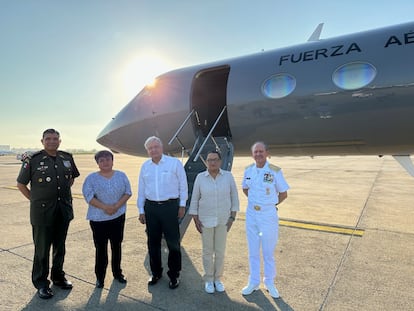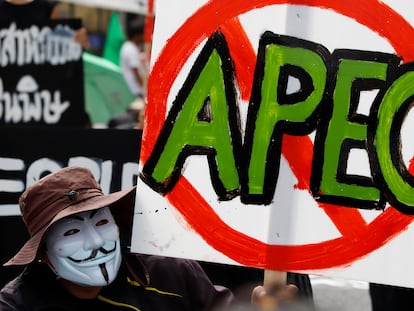López Obrador opens to the world at APEC summit in San Francisco
The Mexican president is due to hold bilateral meetings with the presidents of China, Japan the United States, and Canada. Migration and fentanyl are expected to be on the agenda when he sits down with Joe Biden and Xi Jinping

San Francisco is showing its best, cleanest face for the world leaders from 21 countries who have arrived here for the Asia Pacific Economic Cooperation (APEC) Forum. But the summit is also evidencing the tensions that the most relevant event in seven decades has caused in the city. On Wednesday, several groups demonstrated in favor of an independent Taiwan. Meanwhile, dozens of members of the Chinese sect Falun Gong were protesting against the presence of Chinese leader Xi Jinping, while others welcomed the leader of the Communist Party by waving red flags. Xi met for two hours with Joe Biden in a show of rapprochement between the world’s greatest powers.
Andrés Manuel López Obrador arrived in this bustling city shortly before 8 p.m. local time on Wednesday. The Mexican president has consistently reduced his presence at international forums, where he has been mostly represented by the Foreign Ministry. He prefers to be a host rather than a visitor, as evidenced in October with a summit where he sought to position himself as Cuba’s mediator with the United States. However, in his fifth year in government, as he heads towards the end of his term in office, López Obrador has opened himself to the world. This is his third trip abroad since September to meet with international counterparts.
López Obrador will meet with Xi Jinping on Thursday morning. At 1 p.m. he is due to hold a meeting with Japanese Prime Minister Fumio Kishida. In the afternoon he will have a bilateral meeting with Canadian Prime Minister Justin Trudeau. And on Friday, before the forum ends, he will meet with U.S. President Biden, the fourth time during his presidency that both men will have got together. The last time was at a regional summit held in January of this year in Mexico City.
Just a few blocks beyond the impressive security rollout in the Union Square area, the most problematic face of San Francisco is on clear display. Homeless people wander around just a few feet away from the summit’s entrance points. Some are lying on the ground. Drug pipes and small bags with suspicious-looking substances can be seen lying close to them. It is easy to see the damage that fentanyl has caused, not just on this side of the border, but also in the Mexican cities close to it. Summits like this one must show that they can change a reality that will cause, in San Francisco alone, more than 800 overdose deaths this year.
The powerful synthetic opioid is not the only issue that will be addressed at the APEC summit, but it has crept into the agenda among other urgent matters such as climate change, artificial intelligence and economic recovery. The fight against fentanyl will be inevitable in the meeting between Xi and López Obrador, who lead the two nations that are flooding the United States with the drug, according to Washington. The Mexican president has insistently stated that fentanyl is not manufactured in Mexico, but local drug cartels are helping smuggle it into the U.S.
Another inevitable topic for the Mexican president, especially during his meeting with Biden, will be migration. It is, in fact, the only issue that is explicitly discussed in a bulletin issued Monday by the White House. A delegation led by Secretary of State Antony Blinken visited the Mexican capital in October to hold a tense meeting after Washington’s announcement of an expansion to the border wall. It was also the first time that migration was treated as a national security issue between both governments.
There is an almost unanimous opinion in the United States that the border with Mexico is in chaos, with the highest number of illegal crossings in four years being registered. October gave the immigration authorities a break, as there was a drop in the numbers of arrests: 188,000 compared with 218,000 in September. The October figures broke a three-month upward trend in the area, which saw Venezuelans become the largest nationality attempting to cross, surpassing Mexicans for the first time. In response, the Biden administration reactivated mass deportations to Caracas despite the lack of diplomatic relations with the Nicolás Maduro regime.
On October 23, López Obrador announced that he will raise the possibility of the U.S. resuming diplomatic contacts with Cuba and thus normalize relations between Washington and the island. “Let the United States open dialogue,” said the Mexican leader, who wants the U.S. to lift its economic sanctions against Havana. “I hope it starts as soon as possible, for humanitarian reasons. There is condemnation from all the countries in the world; at each U.N. assembly, the majority votes to lift the embargo,” he said.
Those statements were made after López Obrador organized a summit in Palenque (in the southern Mexican state of Chiapas) with 10 countries in the region to address the migration crisis. At this gathering, the Cuban leader Miguel Díaz-Canel and Venezuela’s Maduro stood out as guests. Mexico sought a two-way play: to establish itself as Washington’s chief interlocutor with Caracas and Havana, and to relaunch its leadership in Latin America. López Obrador, however, missed an opportunity to establish himself in that role by snubbing the Americas Partnership for Economic Prosperity held on November 3 at the White House.
Sign up for our weekly newsletter to get more English-language news coverage from EL PAÍS USA Edition
Tu suscripción se está usando en otro dispositivo
¿Quieres añadir otro usuario a tu suscripción?
Si continúas leyendo en este dispositivo, no se podrá leer en el otro.
FlechaTu suscripción se está usando en otro dispositivo y solo puedes acceder a EL PAÍS desde un dispositivo a la vez.
Si quieres compartir tu cuenta, cambia tu suscripción a la modalidad Premium, así podrás añadir otro usuario. Cada uno accederá con su propia cuenta de email, lo que os permitirá personalizar vuestra experiencia en EL PAÍS.
¿Tienes una suscripción de empresa? Accede aquí para contratar más cuentas.
En el caso de no saber quién está usando tu cuenta, te recomendamos cambiar tu contraseña aquí.
Si decides continuar compartiendo tu cuenta, este mensaje se mostrará en tu dispositivo y en el de la otra persona que está usando tu cuenta de forma indefinida, afectando a tu experiencia de lectura. Puedes consultar aquí los términos y condiciones de la suscripción digital.
More information
Archived In
Últimas noticias
Most viewed
- Reinhard Genzel, Nobel laureate in physics: ‘One-minute videos will never give you the truth’
- Oona Chaplin: ‘I told James Cameron that I was living in a treehouse and starting a permaculture project with a friend’
- Pablo Escobar’s hippos: A serious environmental problem, 40 years on
- Charles Dubouloz, mountaineering star, retires at 36 with a farewell tour inspired by Walter Bonatti
- Why we lost the habit of sleeping in two segments and how that changed our sense of time










































